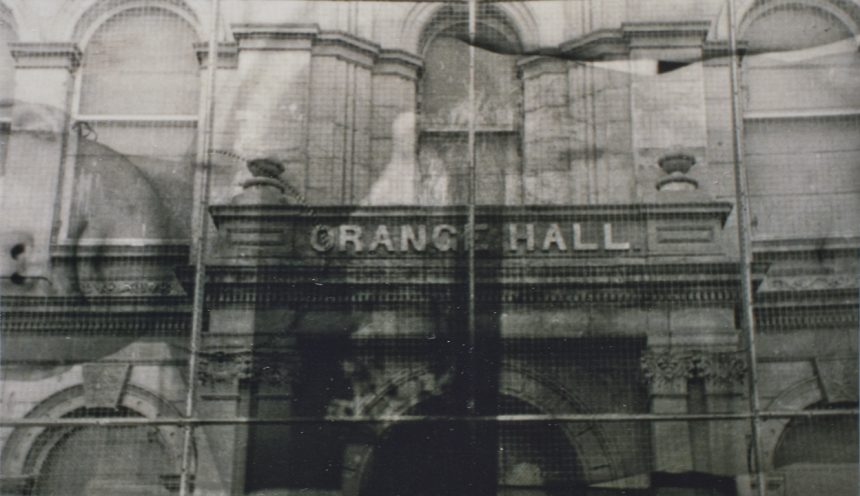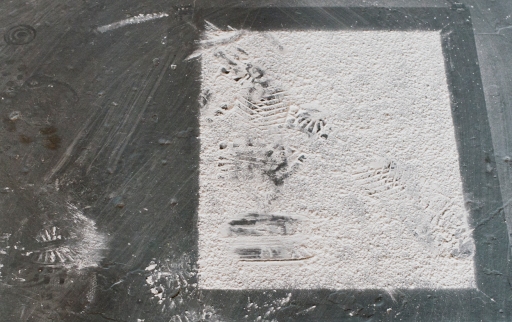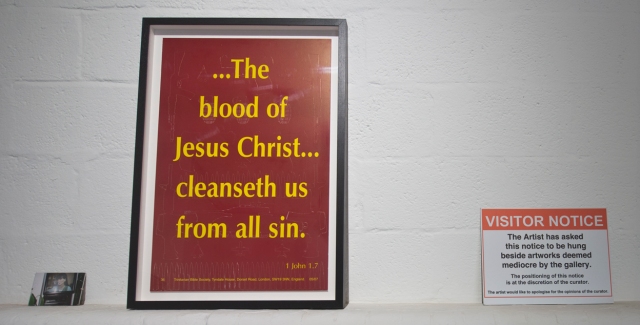Precursor at Catalyst Arts Gallery
From original published on August 16, 2013, by Slavka Sverakova.
Veni, vidi
81 artworks from 81 artists, one, John Ryan, invited, the rest all paying members of Catalyst Arts. It was founded twenty years ago, as Peter Richards puts it in an accompanying brochure, ‘homeless’, appropriating temporary spaces and site specific projects until in 1994 it opened its first gallery at 5 Exchange Place . Two other sites later, it now installs exhibitions in a large downstairs space, addressed as 5 College Court, facing a car park.
“It has exhibited artists from all quarters of the globe, hosted exhibitions, events, festivals, talks, seminars; and has been transformed by artists into a cinema, a recording studio, a sauna, a club, various clubs and so much more” (Peter Richards, Né en 1993, Sans Abri)
While willingly changing its colour, like a chameleon, Catalyst Arts held to its character: open to opportunities, offering support, guarding the quality. The current exhibition shares those fully. It was not my considered plan to focus on a small number, yet focus I did on those remembering a past. Memory.
A large charcoal and mixed media drawing Mnemosyne by Margaret Woods injects classical myth as a root of all else, that being what we remember, why and how. In the Greek mythology Mnemosyne is a confident mother of the Nine Muses – here, on her own, deep in thoughts, perhaps catching an insecure tear with a hesitant gesture, she appears to be slowly, gently disappearing. Her left hand has not been fully drawn, and now it looks like having evaporated from the surface, it looks flawed like a memory. Her right hand seems to appear twice, once fully formulated and, once a little lower to the right, as if touching the left shoulder. Together they forge a -V- shape of two clock hands anchored in Mnemosyne’s lap, near the deformed limb, measuring a small interval of time.
Time Was by Alice Clark is a veritable delight of nimble fingers collecting seed heads of dandelions and placing them in a glass bowl, like jewels measuring time.
An elegant reminder of the law of nature, the little sculptural installation evoked both domestic comforts and inescapable laws of nature. Calliope, the Muse of epic poetry would have been protective of it. Whereas the next image would come under the care of Clio, the Muse for history.
David Dunne evoked the dry dating of documents in a sophisticated collage of old prints titled Prelude Berlin, 1933, fragments of monstrous behaviour and monstrous tragedy fit of attention of the Muse Melpomene. Dunne framed the central headless figure in a pose of deep thinking by myth and history. It is not true and yet it is. The layers of incongruous events do not obey historical continuity, a device favoured also by the next two exhibits. Time received a grid treatment in Christopher Gillen’s ‘Dislocation’ , a facade imprisoned behind a right angled net.
The grid looks like functional scaffolding, until the attention is directed to the other images layered over the facade of the Orange Hall – a horizontally placed head on the left, and the statue as if on the balcony indicate additions during the process of printing. Like a memory layers, some are almost not legible, others lose their link with the truth by wiggling out of scale and/ or believable direction, a surreal touch.
The sequence of what is where defines the vertically stretched installation by Anne Marie Taggart.
Visitors imprinted their shoes on the soft surface of the white rectangle on the floor, removing some of the white pigment from it, making then new prints elsewhere.
Chance transfer of the pigment is a pre-ordered principle of participation. While the vertical set of floor image, voluminous tube and a feathered wing works a visualisation of addition, the dissipation of the right angled form by “dancing” shoes is a reminder of the lightness preferred in a play. To the delight of the Muse of dance, Terpsichore.
The idea of addition and/or subtraction appeared most triumphantly in two objects, displayed next to each other.
Janet Morris made a tiny assemblage, Mention, whose muted colours suppress the relief into something near an abstract painting. Arte povera comes to mind quite easily as an older sibling.
Her assemblage provided a friendly whisper of togetherness to Zoe Murdoch’s box M153.
This has been exhibited at Fenderesky Gallery few years ago, but
Unfortunately this year the piece got broken (unusually it was not broken by myself!) so I fixed it up and added a few little improvements and thought it deserved another outing so I put it into the member’s show at Catalyst…
As if deliberately made for reminiscing about time the M153 used to be a drawer in an old workshop chest offered for sale at a car boot sale in the middle of nowhere, somewhere in Pennsylvania
The work was inspired after a trip to Pennsylvania in 2011 to visit my friend – a fellow artist called Susan Moloney …We went to visit a town called New Hope, nearby was a beautiful old abandoned railway line and this is where I found the piece of rusty metal right by the old rail tracks… (quotes from Murdoch’s email to me)
The use of old, almost discarded, values during the time framed by friendship with another artist is iconic one in relation to the ethos of Catalyst Arts over the two decades.
I recall the deeply felt pathos of the Italian Mutus Liber or of the two Mexican performance artists working in the freezing gallery as being symptomatic of the freely given time and energy by all Catalyst Arts members.
However, to lighten the mood, there is a joker in the pack: the trinity of prints is a nod to the Muse of comedy Thalia. Nathan Crothers’s ‘Notice’ is the spanner between the dual meaning of Brendan O’Neil’s ‘With God on our side’ and Ben Crothers’s ‘Sarah, Home & Away’.
On the left the photograph by Ben Crothers; in the middle the scalpel etched poster by Brendan O’Neill, on the right Nathan Crothers’s C- print on dibond aluminium. Photo Jordan Hutchings.
I have felt the blessing of this relaxed exhibition for its capacity to embrace effortlessly the many differences in contents, media, modes and paradigms. The exhibition that was not bound to one concept, instead it was youthfully multitasking.













